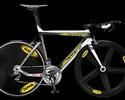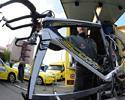
Recently on Cyclingnews.com |
Race tech: May 12, 2008
Scott unveils faster and lighter Plasma2 time trial frame at Giro d'Italia
By James Huang
|
|
|
|
|
Saunier Duval-Scott riders tackled the fast and flat team time trial of this year's Giro d'Italia opening stage aboard brand new Scott Plasma2 framesets that are claimed to be a full 20 percent more aerodynamic than before. Tubing profiles have been narrowed across the board to reduce frontal area but a number of specific features help clean up the airflow from front to rear as the bike makes its way to the finish line.
As compared to the old fork which was essentially just borrowed from the road lineup, the Plasma2 fork is now a proper aero bit that is not only well integrated into the rest of the chassis but also works with the newly dropped and cut-out down tube to yield a more continuous surface with the front wheel. The rear wheel is also well protected with a claimed 80 degrees of coverage from the deeply profiled seat tube but the new bottom bracket area is arguably the most visually striking area of the frame.
The new 'Speed Skeg' shell design is expectedly well reinforced but it also extends further down than typical and terminates in a small spoiler that supposedly helps direct air around the churning wheel. The connecting chain stays are then oriented perfectly horizontal behind the shell for roughly two-thirds of their length, which Scott claims provides better shielding from the turbulent air in that region.
Aero-enhancing details are also well thought out, such as the uniquely profiled water bottle bosses, fully internally routed cables that enter the frame behind the stem, and adjustable rear dropouts.
All of this additional surface area would normally be associated with additional weight but Scott has managed to make the aero improvements without adding any appreciable mass. Last year's CR1 tube-to-tube construction techniques have been traded for the more mass-efficient Integrated Molding Process on the new top tube, head tube, down tube, seat tube and front chain stay sections and the fiber content has been upgraded to Scott's top-end HMX blend. As a result, the claimed frame and fork weights of 1340g and 400g for a medium-sized sample are roughly inline with last year's Plasma.
Aerodynamic performance isn't the only area of improvement, either. The bigger top tube and down tube should increase torsional rigidity of the front triangle for better power transfer and handling precision, the new seat stay design is supposedly more comfortable, and a new Ritchey head on the integrated seat mast includes far more fore-aft adjustment before to provide effective seat tube angles ranging from 73-78 degrees. A new extra-small (47cm) size will also be added (built around 700c wheels, no less) to cater to the vertically-challenged crowd.
Photography
For a thumbnail gallery of these images, click here
Images by Roberto Bettini/www.bettiniphoto.net
- Saunier Duval-Scott riders came to the Giro d'Italia ready to race with the new Scott Plasma2 time trial bike.
Images by Scott Sports SA
- Scott claims the new Plasma2 is 20 percent more aerodynamic than the original Plasma.
- The beefier front triangle includes a dropped down tube and a cutout for the front wheel.
- The rear wheel cutout is expectedly deep and covers nearly a quarter of the wheel's circumference.
- Tube profiles have been narrowed across the board to minimize frontal area.
- The new Speed Skeg bottom bracket shell design is claimed to significantly clean up airflow in the region and redirect air around the rear wheel.
- The Plasma2 finally gets a proper aero fork that integrates well with the rest of the frame.




